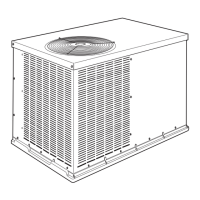9
3. Insulate the temperature sensing device so that the outdoor
ambient doesn’t affect the reading.
4. Refer to the required subcooling in Tables 3 and 4 to find the
required subcooling based on themodel sizeand theoutdoor
ambient temperature.
5. Interpolate if the outdoor temperature lies in between the
table values. Extrapolate if the temperature lies beyond the
table range.
6. Find the pressure value corresponding to the measured
pressure on the compressor discharge line.
7. Read across from the pressure reading to obtain the Liquid
line temperature for a required subcooling.
8. Add charge if the measured temperature is higher than the
liquid line temperature value in the table.
9. Add charge using the service connection on the suction line
of the compressor.
Step 4—Indoor Airflow and Airflow Adjustments
NOTE: For cooling operation, the recommended airflow is 350 to
450 cfm for each 12,000 Btuh of rated cooling capacity .
Table 6 shows dry coil air delivery for horizontal discharge units.
Tables 9 --10 show pressure drops.
NOTE: Be sure that all supply-- and return-- air grilles are open, free
from obstructions, and adjusted properly.
ELECTRICAL SHOCK HAZARD
Failure to follow this warning could result in personal injury
or death.
Disconnect electrical power to the unit and install lockout tag
before changing blower speed.
!
WARNING
Airflow can be changed by changing the lead connections of the
blower motor.
All 50ZPA blower motors are factory wired for rated airflow
operation.
FOR 208/230V BLOWER MOTORS
The motor lead speed connections are as follows:
SIZE RATED AIRFLOW HIGH AIRFLOW
024 Ta p 1 Tap 3
030 Ta p 2 Tap 4
036 Ta p 1 Tap 3
042 Ta p 2 Tap 4
SIZE
RATED AIRFLOW HIGH AIRFLOW
Low
Stage
High
Stage
Low
Stage
High
Stage
048 Tap 1 Tap 3 Ta p 2 Ta p 4
060 Tap 1 Tap 3 Ta p 2 Ta p 4
Step 5—Unit Controls
All compressors have the following internal--protection controls.
HIGH--PRESSURE RELIEF VALVE
This valve opens when the pressure differential between the low and
high side becomes excessive.
LOW--PRESSURE SWITCH
Located on the outdoor liquid line is a low-- pressure switch which
functions as a loss-- of--charge switch. This switch contains a
Schrader core depressor. This switch opens at 7 psig and closes at22
psig. No adjustment is necessary.
COMPRESSOR OVERLOAD
This overload interrupts power to the compressor when either the
current or internal temperature become excessive, and
automatically resets when the internal temperature drops to a safe
level.
This overload may require up to 60 minutes (or longer) to reset;
therefore, if the internal overload is suspected of being open,
disconnect the electrical power to the unit and check the circuit
through the overload with an ohmmeter or continuity tester.
COMPRESSOR ROTATION
On 3--Phase units it is important to be certain compressor is rotating
in the proper direction. To determine whether or not compressor is
rotating in the proper direction:
1. Connect service gages to suction and discharge pressure
fittings.
2. Energize the compressor.
3. The suction pressure should drop and the discharge pressure
should rise, as is normal on any start--up.
Ifthe suction pressure doesnot dropand thedischarge pressuredoes
not rise to normal levels:
1. Turn off power to the unit and tag disconnect.
2. Reverse any two of the unit power leads.
3. Turn on power to the unit.
The suction and discharge pressure levels should now move to their
normal start--up levels.
NOTE: When the compressor is rotation in the wrong direction, the
unit makes an elevated level of noise and does not provide cooling.
Step 6—Sequence of Operation
FAN OPERA TION
The FAN switch on the thermostat controls indoor fan operation.
When the F AN switch is placed in the ON position, the IFR
(indoor--fan relay) is energized through the G terminal on the
thermostat. The normally --open contacts close, which then provide
power to the indoor (evaporator)fan motor(IFM). TheIFM will run
continuously when the FAN switch is set to ON.
When the FAN switch is set to AUTO, the thermostat deenergizes
the IFR (provided there is not a call for cooling). The contacts open
and the IFM is deenergized. The IFM will be ener gized only when
there is a call for cooling, in air conditioner heating mode or if the
unit is equipped with accessory electric heat, the indoor-- fan motor
will also run while the accessory electric heat is energized.
NOTE: Some units are equipped with a time--delay relay. On these
units, the indoor fan remains on for 30 seconds after G or Y is
deenergized.
COOLING OPERATION (SIZES 024 --042)
With acallfor cooling (Y/Y2),the indoorfan energizesimmediately
whereas the contactor energizes after a 5 minute time delay (in case
of initial start--up) starting the compressor and the outdoor fan
motor . When the cooling demand is met, Y/Y2 de--energizes,
shutting the compressor, indoor fan and the outdoor fan.
50ZPA

